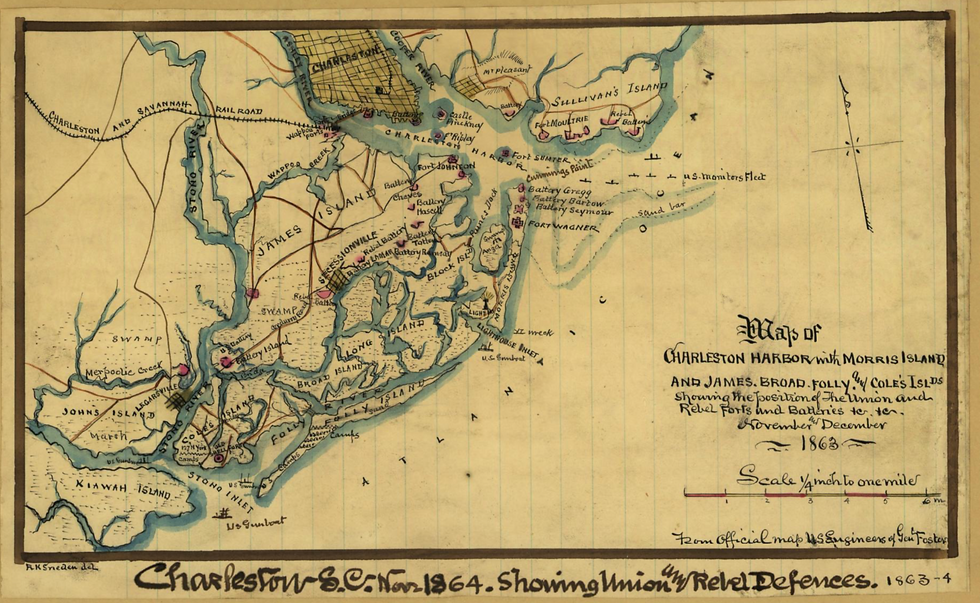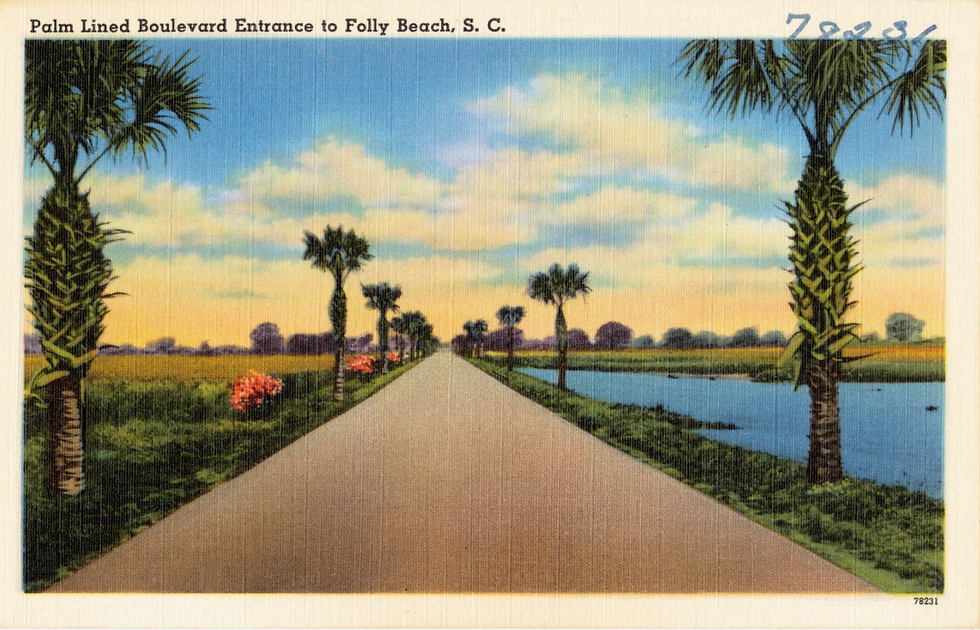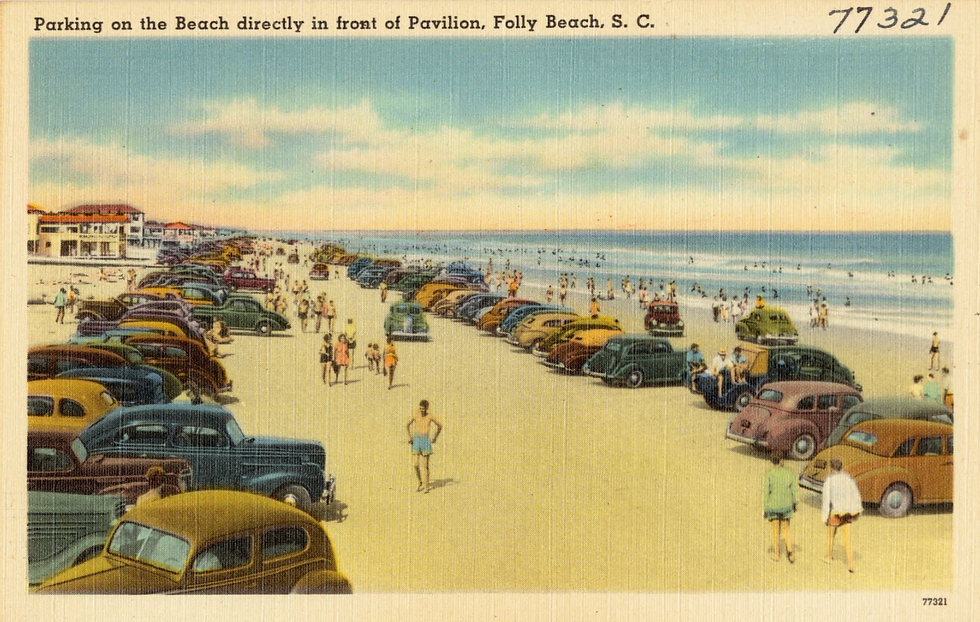Discover the Rich History and Vibrant Community of Folly Beach, South Carolina
- CHSMLS

- Jul 22
- 6 min read
Updated: Aug 12
Folly Beach is a lovely oceanside community located on Folly Island and easily accessible by crossing James Island. Folly is a barrier island, or a long, sandy strip of land that is part of a dune system created by tidal action. Folly is bounded by the Atlantic Ocean and Folly Creek and sits between Morris Island (with its famous lighthouse, one can walk to from Folly at low tide) and Kiawah Island. Folly Beach is a fun beach town with a kitsch 1950s history and is known as Charleston’s favorite summer playground. Today, it remains popular with vacationers and year-round residents who are attracted to the beach, waterfront views of marshes, water activities, and a relaxing pace of life.


The Early Days: Folly Beach Civil War History
Folly was home to the Bohicket Native American tribe before it was granted to the Rivers family in the early colonial era. The island is sandy, so it was not cultivated as plantations like the neighboring sea islands. Sleepy Folly became an important staging point for the Union during the American Civil War, as the troops tried to create a stronghold for guns with which to bombard Charleston during a 587-day long siege. Nearly 13,000 Union soldiers spent time stationed on Folly Island, building batteries and camping. The 54th and 55th Massachusetts, famous as some of the earliest Black Union units, fought and died on Folly and Morris, and were later memorialized in the movie Glory. Folly grew quiet again after the war, with visitors arriving by boat to camp on the rural island.


Roaring 20s and Artist Haven
In 1919 the Folly Beach Corporation created the island’s first subdivision of 214 lots, marketed for vacation homes for buyers who could reach the island from Charleston along a newly paved Folly Road and toll bridge. 200,000 visitors came to folly in 1925, a historic peak. The local paper reported excitedly:
“FOLLY BEACH DEVELOPMENT ON BIG SCALE. Concrete Hotel, Huge Pavilion, Widened Roads. Alligator and Ostrich Farms Also to be Featured. A beach resort that will rank among the finest and most attractive of its kind on the Atlantic coast is the ultimate goal of the purchasers of the property of the Folly Beach Corporation and the property and rights of the Folly Roadway Company… A widened and modern highway, a hotel, bathing pavilion with a swimming pool and various other features of amusement and recreation are included in the program. It is felt that such a resort will attract thousands of visitors in the course of a season. At the present time the ride to Folly Beach is through a section rich in natural beauty, and the proposed adornment of the highway will add much to its attractiveness. It is not difficult to visualize great number of autoists motoring to Charleston for the purpose of visiting Folly Beach… one of the few seaside resorts of its type anywhere that is so easily accessed by automobile...”

Folly Pier opened in 1931, Oceanfront Hotel was completed in 1934, and surfside restaurants and stores followed. The News and Courier reported in 1932 that a four-unit apartment was under construction (a first for the island), a log cabin and a new brick house were being built, and a post office had just opened.
Folly’s natural beauty attracted artists and writers from up and down the east coast, including locals who were part of the Charleston Renaissance, an interwar era arts and literary boom that brought the Lowcountry to a wider audience. DuBose and Dorothy Heyward, an author and playwright respectively, built a house on the island in 1932, and painter Alfred Hutty bought a beach lot that year as well. Edward Hopper painted a landscape dune scene of Folly in 1929 (now at the MET). It was in Heyward’s Folly Beach cottage that Dubose collaborated with Ira Gershwin in 1934 to write Porgy and Bess, one of America’s most famous operas, which was set in Charleston and included the well-loved song “Summertime.”
1950s Surfing and Amusements
Folly burgeoned after World War II as auto tourism gained popularity, and by the 1950s, the beachfront was dotted with more shops, a skating rink, and an amusement park. Back then, beachgoers could drive right onto the beach.


Locals danced the shag (the state’s official dance) at Atlantic Boardwalk and Pavilion and listened to live orchestras and bands under the stars. Visitors enjoy similar beachside restaurants and ice cream stands we find on Folly today, even though Atlantic Boardwalk has been replaced.


Erosion, two fires that decimated the pier in 1957 and 1977, hurricanes like Gracie in 1959 and Hugo in 1989, and competition with other beaches like Myrtle took a toll on Folly. Christina Butler notes that, “’Hugo’s erosion damage also created the Washout, a popular surfing spot. Hugo did bring a new addition to the island- the famous Folly Boat, which was washed ashore in the storm and marks entry onto the island, and is a brightly painted canvas of ever-changing street art.” By the early 1990s, the beach town was having a renaissance that has not ceased. The Tides Hotel opened in 1985, Taylor Pier was completed in 1995, and the island continues to attract part-timers, vacationers, and 2,400 full-time residents.
Folly Beach Today
Folly Beach remains a laid-back surfing community with Center Street, the island’s main street, offering restaurants, surf and beach shops, bars, and small businesses. Taylor Pier is a favorite fishing spot, there are surf schools and paddleboarding, and kayak rentals for visitors or locals who don’t have their own equipment, Wave Watch Playground, Folly Beach County Park, and several public access points to get to the beach for a swim and sunbathing.


Rita’s Surfside Grill, Jack of Cups bar, Taco Boy, Lowlife Bar, Lost Dog Café, and Loggerhead’s Beach Grille are just some of the popular places to eat on the island. Locals also love to visit Bowen’s Island on the way from Charleston to Folly, a “bare bones fish shack with waterfront views” and delicious fresh seafood off the beaten path on a small creek off of Folly River.
James Island offers grocery stores, gas stations, good schools, and big box stores an easy short drive away. There are a few vacant lots for sale on the island, as well as condos with reasonable starting price points, neotraditional style beach-front new villas, and historic wood frame cottages still dot the island and occasional go for sale. It’s easy to see why Folly residents are proud of their community and work hard to preserve its welcoming character and natural vistas.
--
At CHS Regional MLS, we’re more than a database—we’re your partner in real estate success. Follow us on Facebook and Instagram for updates and insights, and join today to connect with the Lowcountry’s most comprehensive property network.
Sources:
Stephanie Hunt. “Learn the histories of Isle of Palms, Sullivans Island, and Folly Beach.” Charleston Magazine. June 2020
Charleston News and Courier (Published as The News and Courier) - May 7, 1932
Charleston News and Courier, 13 January 1925.
Library of Congress maps and photo collections
Stratton Lawrence. Images of America: Folly Beach. Charleston: Arcadia Press, 2013
Massachusetts Digital Commonwealth, Tichnor Brothers postcard collection
College of Charleston. “An Educator’s Guide to Folly Island.” http://oceanica.cofc.edu/An%20Educator%27sl%20Guide%20to%20Folly%20Beach/guide/FBHistory.htm
Gretchen Stringer-Robinson. Time and Tide on Folly Beach, South Carolina. Charleston: Reprint, 1998.
William James Hagy. The Edge of America: Folly Beach, A Pictorial History. Charleston: Shaftsbury Books, 1997
Leigh Handal. Lost Charleston. London: Pavilion Books, 2019.
Christina Butler. “Folly Beach.” Charleston Empire Properties. 2020.






